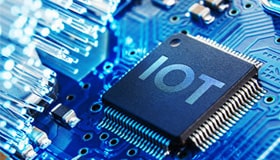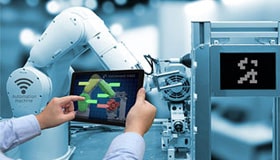Data Manipulation in Smart Sensors
No longer limited to simply passing an electrical-measurement signal, smart sensors collect, convert, and process data and offer machine-to-machine communication. This trend has blurred the traditional definition of an edge device and given rise to the notion of the extreme edge utilising smart sensors.
These smart sensors handle the burden of processing, intelligence, data processing, and other functionality to increase overall performance and enhance power efficiency. In addition, the local computational power of smart sensors enables predictive maintenance, improved productivity, and flexible and responsive manufacturing.
Smart Sensor Architecture
There are three important aspects of smart sensor design- data acquisition, data processing, and data communication. At a minimum, a smart sensor comprises a sensor element, a microprocessor, and a communication technology. It also incorporates software-defined elements that provide data conversion, digital processing, and communication to external devices and the cloud. A smart sensor can support various sensing technologies in more advanced cases, handling and delivering multiple measurement values.
Figure 1 provides a generic example of a smart sensor's architecture that contains the most common functions. The signal chain in a smart sensor node starts with the core sensor function. Many of these produce low-level analog outputs that require precision signal conditioning to preserve the critical information they gather. Signal conditioning functions include sensor excitation, signal amplification, anti-alias filtering, low-pass, and high-pass filtering, linearisation, and an often overlooked but an essential feature—isolation.

Figure 1: Smart Sensor Architecture
Several types of devices can be used as processing units-Microcontrollers, SoC and FPGA. The choice of each depends on the complexity and functionality of the smart sensor. Processing units integrated into smart sensors are much more sophisticated, incorporating excitation sources, high-resolution analog to digital (A to D) and D to A converters, general-purpose discrete I/O, fast architectures, math support, and low-power modes. The embedded intelligence continuously monitors the discrete sensor elements, validates the provided engineering data, and periodically verifies sensor calibration and health. The essential difference of the smart sensor from the integrated sensor with embedded data-processing circuitry is its intelligence capabilities (self-diagnostics, self-identification, or self-adaptation (decision-making)) functions). Using a processor-based system inside sensors can potentially bring significant benefits over simple sensor designs - better accuracy, reliability, fault detection, advanced power management, flexible design cycle, and additional features, etc.
Smart sensors can be connected via a range of different interfaces using non-contact, optical/inductive connections or 'wirelessly' via passive or active radio technology. The choice of interface depends upon the requirements and demands, such as the power supply, range, and miniaturisation. The communication/storage function supports data staging and connectivity with IoT cloud services (encryption/security, storage, and analytics). Eventually, the communication module manages the communication between the smart sensor system and external devices (local, remote, or monitoring stations).
Smart Sensor Ecosystem
A differentiator of the smart sensor is its role in the broader information and analytics ecosystem. Integrating smart sensors throughout the supply chain can decrease operating costs, increase asset efficiency, and improve demand planning. Transmission standards such as WiFi, Bluetooth, NFC, RFID, and others are then used to communicate this data to other sensors, controller devices, centralised management platforms, or distributed computing platforms for data aggregation and analysis (Figure 2).

Figure 2: Smart Sensor Ecosystem
Smart sensors’ data is usually processed and stored in an external database or a cloud computing platform. Usually, sending data straight to the cloud can also be problematic in large systems containing a range of sensors from different suppliers. These may use different protocols to transmit their information. The more common way of getting data out of smart sensors is to use a bridging device known as a gateway in each room. A gateway receives data from the sensors and makes it usable. Data is transmitted from the smart sensors to the gateway wirelessly. The gateway then converts the smart sensors data and sends it wirelessly via Wi-Fi and LTE or a wired Ethernet cable to a chosen local or cloud-based platform.
Instead of processing and storing data on the cloud, users can create a dashboard more locally using an application. This allows constructing a simple dashboard to display the data being received by the gateway without needing to sign up to one of the cloud platforms.
A key factor in realising the full potential of smart sensor technology is how it can be linked to remote technical support. Digital communication capabilities allow application and product specialists to access sensor-setting files. A specific sensor configuration can be uploaded and downloaded through the communication protocol or an external sensor communication tool. Technicians can remotely modify sensor settings to new application demands and requirements by evaluating a downloaded sensor setting file from the application field site, factory, or laboratory. This enables a remote simulation and evaluation of sensor behavior and diagnostics by technical experts, which can be beneficial support when configuring or fine-tuning sensors in the design-in phase.

For example, Layer N SS-002-1 Smart Sensors from Omega Engineering offers a configurable mix of any three of the four internal sensors: Temperature, Humidity, Barometric Pressure, Ambient Light, plus one external sensor option: Thermocouple, RTD, or DIN (contact closure). Transmission ranges of up to 1.2 km can be achieved with the standard AA batteries, and transmission ranges of up to 3.2 km can be achieved when powered by a standard 5V micro USB 2.0 cable. Layer N Smart Sensors can be easily paired to the Layer N Gateway with the press of a button and automatically show up on Layer N Cloud Account. The Layer N Gateway can connect up to 256 Smart Sensors per unit. Local data logging keeps data secure in the event of a power or network outage. Reports, History, and E-mail alerts from the Layer N Cloud keeps the system informed on all vital processes' status.
For additional information on smart sensors and key trends in sensor development, read our whitepaper on Smart Sensor-enabling the intelligent Internet of Things'.
Stay informed
Keep up to date on the latest information and exclusive offers!
Subscribe now
Thanks for subscribing
Well done! You are now part of an elite group who receive the latest info on products, technologies and applications straight to your inbox.






